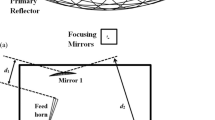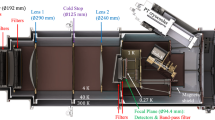Abstract
The latest generation of Cassegrain radio astronomy antennas is designed for multiple frequency bands with receivers for individual bands offset from the antenna axis. The offset feed arrangement typically has two focusing elements in the form of ellipsoidal mirrors in the optical path between the feed horn and the antenna focus. This arrangement aligns the beam from the offset feed horn to illuminate the subreflector. The additional focusing elements increase the number of design variables, namely the distances between the horn aperture and the first mirror and that between the two mirrors, and their focal lengths. There are a huge number of possible combinations of these four variables in which the optics system can take on. The design aim is to seek the combination that will give the optimum antenna efficiency, not only at the centre frequency of the particular band but also across its bandwidth. To pick the optimum combination of the variables, it requires working through, by computational mean, a continuum range of variable values at different frequencies which will fit the optics system within the allocated physical space. Physical optics (PO) is a common technique used in optics design. However, due to the repeated iteration of the huge number of computation involved, the use of PO is not feasible. We present a procedure based on using multimode Gaussian optics to pick the optimum design and using PO for final verification of the system performance. The best antenna efficiency is achieved when the beam illuminating the subreflector is truncated with the optimum edge taper. The optimization procedure uses the beam’s edge taper at the subreflector as the iteration target. The band 6 receiver optics design for the Atacama Large Millimetre Array (ALMA) antenna is used to illustrate the optimization procedure.





Similar content being viewed by others
References
J. W. Lamb, Optimized Optical Layout for MMA 12-m Antennas, MMA Memo 246, The Atacama Large Millimetre Array Project, National Radio Astronomy Observatory, The National Science Foundation, 15 January 1999. (https://library.nrao.edu/alma.shtml).
J. W. Lamb, A. Baryshev, M. C. Carter, L. R. D’Addario, B. N. Ellison, W. Grammer, B. Lazareff, Y. Sekimoto, and C. Y. Tham, ALMA Receiver Optics Design, ALMA Memo 362, The Atacama Large Millimetre Array Project, National Radio Astronomy Observatory, 11 April 2001. (http://library.nrao.edu/alma.shtml)
J. W. Lamb, Low-Noise, High-Efficiency Optics Design for ALMA Receivers, IEEE Transactions on Antennas and Propagation, vol. 51(8), pp. 2035–2047, August 2003.
G. A. Ediss, M. Carter, J. Cheng, J. E. Effland, W. Grammer, N. Horner, Jr., A. R. Kerr, D. Koller, E. F. Lauria, G. Morris, S. –K. Pan, G. Reiland and M. Sullivan, ALMA Band 6 Prototype Cartridge: Design and Performance, in Proc. 15th Int. Symp. Space Terahertz Technology, Northampton, Massachusetts, 27–29 April 2004, pp. 181–188. (Also ALMA Memo 502, The Atacama Large Millimetre Array Project, National Radio Astronomy Observatory, 21 June 2004. https://library.nrao.edu/alma.shtml)
M. Carter, A. Baryshev, M. Harman, B. Lazareff, J. Lamb, S. Navarro, D. John, A. –L. Fontana, G. A. Ediss, C. –Y. Tham, S. Withington, F. Tercero, R. Nesti, G. H. Tan, Y. Sekimoto, M. Matsunaga, H. Ogawa, and S. Claude, ALMA front end optics, Proc. of SPIE, vol. 5489, pp. 1074–1084, 2004.
C. Y. Tham and S. Withington, ALMA receiver optics design electromagnetic analysis: second report (band 3, 6, 7 and 9), University of Cambridge, July 1, 2003, ALMA report FEND-40.01.00.00-004-A-REP. The Atacama Large Millimetre Array Project, National Radio Astronomy Observatory, The National Science Foundation, 1 July 2003.
C. Y. Tham and S. Withington, ALMA receiver optics design electromagnetic analysis: third report (band 4, 8 and 10), University of Cambridge, Dec. 12, 2003, ALMA report FEND-40.01.00.00-005-A-REP. The Atacama Large Millimetre Array Project, National Radio Astronomy Observatory, The National Science Foundation, 12 December 2003.
M. Naruse, T. Ito, Y. Sekimoto, H. Toba, N. Satou, M. Sugimoto, W. Shan, Y. Iizuka, T. Kamba, M. Kamikura, and Y. Serizawa, Near-field beam pattern measurement of qualification model of ALMA band 8 (385–500 GHz) cartridge receiver, Experimental Astronomy, vol. 24(1–3), pp. 89–107, 2009.
M. Naruse, Y. Sekimoto, M. Kamikura, M. Sugimoto, T. Ito, N. Satou, K. Kumagai, Y. Iizuka, and Y. Fujimoto, Near-field beam pattern measurement of ALMA band 8 (385–500 GHz) first cartridge, Proceedings of the 3rd European Conference on Antennas and Propagation, Berlin, Germany, 23–27 March 2009, pp. 2437–2441.
Y. Sekimoto, Y. Iizuka, N. Satou, T. Ito, K. Kumagai, M. Kamikura, M. Naruse, and W. L. Shan, Development of ALMA band 8 (385–500 GHz) cartridge, Proceedings of the 19th International Symposium in Space Terahertz Technology, Groningen, Netherlands, 28–30 April 2008, pp. 253–257.
A. Baryshev, R. Hesper, K. Wielinga, G. Gerlofsma, and M. Carter, Design and verification of ALMA band 9 receiver optics, Proceedings of the 15th International Symposium in Space Terahertz Technology, Northampton, Massachusetts, 27–29 April 2004, pp. 433–440.
P. F. Goldsmith, Quasioptical systems; Gaussian beam, quasioptical propagation and applications, New York: IEEE Press, 1998.
C. Y. Tham and S. Withington, ALMA receiver optics design electromagnetic analysis, University of Cambridge, Sept. 4, 2001, ALMA report FEND-40.01.00.00–006-A-REP. The Atacama Large Millimetre Array Project, National Radio Astronomy Observatory, The National Science Foundation, 4 September 2001.
K. Halbach, Matrix representation of Gaussian optics, American Journal of Physics, vol. 32(2), pp. 90–108, 1964.
M. J. D. Powell, A hybrid method for nonlinear algebraic equations, in Numerical methods for nonlinear algebraic equations, P. Rabinowitz (ed.), Gordon and Breach, 1970.
Software - GRASP10 version 10.3.1 from TICRA, Landemaeket 29, DK-1119 Copenhagen K, Denmark, 2014
Acknowledgements
This work was supported in part by the Fundamental Research Grant Scheme funded by Malaysia Ministry of Education (project: FRGS/2/2013/SG02/UTAR/02/1) and Universiti Tunku Abdul Rahman research fund (project: IPSR/RMC/UTARRF/2014-C1/Y03).
Author information
Authors and Affiliations
Corresponding author
Rights and permissions
About this article
Cite this article
Yeap, K.H., Tham, C.Y. Optimization of an Offset Receiver Optics for Radio Telescopes. J Infrared Milli Terahz Waves 39, 64–76 (2018). https://doi.org/10.1007/s10762-017-0449-z
Received:
Accepted:
Published:
Issue Date:
DOI: https://doi.org/10.1007/s10762-017-0449-z




